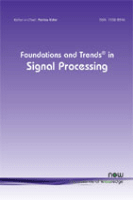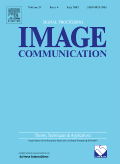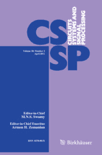
Foundations and Trends in Signal Processing
Scope & Guideline
Pioneering insights in the realm of Signal Processing.
Introduction
Aims and Scopes
- Signal Processing Theory and Algorithms:
This area emphasizes the development of new algorithms and theoretical frameworks that enhance the understanding and application of signal processing methods across various domains. - Machine Learning Applications in Signal Processing:
The journal increasingly highlights the intersection of machine learning and signal processing, exploring how advanced learning techniques can be applied to improve signal analysis and processing tasks. - Quantum Signal Processing:
An emerging focus on quantum phenomena and their implications for signal processing, including quantum machine learning and quantum measurements, reflects the journal's commitment to exploring innovative and cutting-edge topics. - Graph Signal Processing:
This scope delves into the application of graph theory in signal processing, particularly in high-dimensional spaces, thereby expanding traditional signal processing methodologies. - Application-Oriented Research:
The journal aims to publish works that demonstrate practical applications of signal processing techniques in fields such as communications, image processing, and speech and language processing.
Trending and Emerging
- Energy-Based Models in Speech and Language Processing:
Recent publications indicate a growing interest in energy-based models, particularly their applications in speech and language processing, which suggests a trend towards exploring alternative modeling techniques. - Model-Based Deep Learning:
There is an increasing focus on model-based deep learning approaches, highlighting a trend where traditional signal processing techniques are integrated with deep learning frameworks to enhance performance and interpretability. - Meta-Learning in Communication Systems:
The exploration of meta-learning, particularly in the context of communication systems, signifies an emerging trend where learning algorithms are designed to adapt quickly to new tasks with minimal data. - Quantum Machine Learning:
Emerging interest in quantum machine learning reflects a significant shift towards exploring the implications of quantum mechanics on signal processing, positioning the journal at the forefront of this innovative research area. - Graph Signal Processing in High Dimensional Spaces:
The focus on graph signal processing, especially in high-dimensional contexts, indicates a trend towards using advanced mathematical frameworks to tackle complex signal processing challenges.
Declining or Waning
- Classical Signal Processing Techniques:
There is a noticeable decrease in publications focusing solely on traditional signal processing methods, indicating a shift towards more advanced and integrated approaches involving machine learning and quantum techniques. - Basic Statistical Methods in Signal Analysis:
Papers that center on fundamental statistical methods for signal analysis have seen reduced visibility, possibly overshadowed by more sophisticated methodologies that incorporate machine learning and artificial intelligence. - Generalized Frameworks without Specific Applications:
The journal seems to be moving away from publications that propose generalized frameworks lacking specific applications, favoring more targeted research that demonstrates practical use-cases.
Similar Journals

Signal Image and Video Processing
Unveiling the Future of Signal and Image TechnologiesSignal Image and Video Processing, published by Springer London Ltd, is a cutting-edge academic journal dedicated to the fields of electrical and electronic engineering and signal processing. With an ISSN of 1863-1703 and an E-ISSN of 1863-1711, this journal plays a pivotal role in disseminating innovative research findings from 2007 to 2024, boasting a commendable Q2 ranking in its respective categories. Located in the United Kingdom, the journal attracts a diverse readership of researchers, professionals, and students eager to explore advancements in signal processing technologies and their applications in imaging and video analysis. Although it does not offer open access, its rigorous peer-review process ensures the publication of high-quality, impactful research, evident by its respectable rankings within Scopus in both electrical engineering and computer science domains. The journal serves as vital resource for those aiming to stay at the forefront of technological developments and research in image and video processing.

SIGNAL PROCESSING-IMAGE COMMUNICATION
Elevating Standards in Image Communication ResearchSIGNAL PROCESSING-IMAGE COMMUNICATION, published by Elsevier, is a leading journal in the fields of Computer Vision, Signal Processing, and Electrical Engineering. With an impressive range of Quartile rankings in 2023, including Q1 in Electrical and Electronic Engineering and Q2 in Signal Processing, this journal is vital for researchers and professionals seeking the latest advancements and comprehensive studies in image communication technologies. Issued in the Netherlands, SIGNAL PROCESSING-IMAGE COMMUNICATION has been an essential resource since its inception in 1989, fostering innovation and collaboration among academia and industry. The journal provides a platform for high-quality peer-reviewed research, addressing significant challenges and solutions in the convergence of image processing and communication. Although currently not an Open Access journal, it offers subscription options that ensure a broad dissemination of groundbreaking knowledge. With a robust reputation reflected in its Scopus ranks, this journal serves as an indispensable reference for students and experts aiming to stay at the forefront of developments in this dynamic field.

MULTIDIMENSIONAL SYSTEMS AND SIGNAL PROCESSING
Innovating Solutions at the Intersection of Technology and ScienceMULTIDIMENSIONAL SYSTEMS AND SIGNAL PROCESSING is a reputable journal published by SPRINGER that focuses on the interdisciplinary fields of applied mathematics, signal processing, artificial intelligence, and their applications in computer science. Since its inception in 1990, the journal has consistently contributed to advancing both theoretical and practical aspects of multi-dimensional systems and signal processing, making it an essential resource for researchers and practitioners alike. With an impressive 2023 ranking of Q2 in Applied Mathematics and notable positions in multiple computer science categories within Scopus, it demonstrates significant impact and relevance in its field. The journal addresses a wide range of innovative topics, providing a platform for high-quality research that explores complex systems and algorithms. Although not an open access publication, it offers various options for researchers seeking to disseminate their work in a highly regarded venue, ensuring visibility and engagement with the scientific community. Whether you are a seasoned expert or an emerging scholar, MULTIDIMENSIONAL SYSTEMS AND SIGNAL PROCESSING is dedicated to fostering collaboration and dissemination of knowledge in the ever-evolving landscape of technology and applied science.

CIRCUITS SYSTEMS AND SIGNAL PROCESSING
Transforming Ideas into Applications in Circuit and Signal ResearchCIRCUITS, SYSTEMS AND SIGNAL PROCESSING, published by Springer Birkhauser, is a highly regarded journal in the fields of applied mathematics and signal processing, boasting an impact factor that reflects its robust academic contributions. Established in 1982, this journal aims to disseminate cutting-edge research that bridges the gap between theoretical advancements and practical applications in circuit design, systems theory, and signal processing. With a Thomason Scopus ranking of Q2 in Applied Mathematics and Q3 in Signal Processing, it stands out as a leading resource for researchers, professionals, and students seeking to enhance their knowledge and innovate within these disciplines. The journal provides insight into the latest trends and technologies, making it an essential reading for those engaged in the development of signal processing methodologies. Although it does not offer Open Access options, it remains a critical repository of knowledge with deep relevance in today's tech-driven landscape.

International Arab Journal of Information Technology
Advancing Knowledge in Information TechnologyWelcome to the International Arab Journal of Information Technology, a prestigious publication under the aegis of ZARKA PRIVATE UNIVERSITY in Jordan, dedicated to advancing the field of Information Technology. First established in 2008, this journal has made significant strides in disseminating high-quality research, achieving an impressive Q2 ranking in Computer Science (miscellaneous) and securing a notable 57th percentile position in the Scopus rankings. With a comprehensive scope encompassing various sub-disciplines of computer science, the journal is committed to promoting scholarly dialogue and innovation among researchers, professionals, and students. While currently operating as a subscription-only journal, it remains a vital resource for the academic community seeking to explore the latest trends and advancements in technology. The International Arab Journal of Information Technology is not only a platform for original research but also a vibrant hub for ideas that shape the technological landscape of the Arab region and beyond.

Radioengineering
Advancing the frontiers of radioengineering research.Radioengineering is a prominent academic journal published by SPOLECNOST PRO RADIOELEKTRONICKE INZENYRSTVI, focusing on the fields of electrical and electronic engineering. Established in 1992, this open access journal aims to disseminate high-quality research and innovative developments in radioengineering and related disciplines. With an inclusive readership from around the world, it has been integral in fostering advancements in technologies such as wireless communication, signal processing, and electromagnetic theory. The journal's commitment to accessibility is underscored by its open access policy, allowing scholars and practitioners to freely engage with the latest findings. As of 2023, *Radioengineering* holds a Q3 quartile ranking in its field with a Scopus rank of #500/797, placing it within the 37th percentile among its peers. Researchers, professionals, and students engaged in electrical and electronic engineering will find *Radioengineering* an essential resource for both theoretical insights and practical applications. For further information, submissions, and access to articles, please visit the journal’s site linked through the CZECH TECHNICAL UNIVERSITY, located in Prague, Czech Republic.

IRBM
Elevating the Dialogue in Biomedical Engineering and BiophysicsIRBM, published by Elsevier Science Inc, stands at the forefront of research in the domains of Biomedical Engineering and Biophysics, boasting impressively high rankings with a Q1 category in both fields according to the 2023 evaluations. With an effective focus on cutting-edge innovations and methodologies, IRBM provides a vital platform for researchers, professionals, and students alike seeking to disseminate and access groundbreaking findings and developments. Its strong presence in the Scopus database, with ranks of #12 in Biochemistry, Genetics and Molecular Biology and #42 in Biomedical Engineering, places it in the top percentile of impactful journals in the field, making it a crucial resource for advancing knowledge and fostering collaboration. While the journal maintains a traditional subscription model, it continues to attract a diverse readership eager for insightful studies and reviews that push the boundaries of science and engineering. With a projected convergence of years extending to 2024, IRBM promises to remain a significant contributor to the ongoing dialogue in the life sciences.

JOURNAL OF VISUAL COMMUNICATION AND IMAGE REPRESENTATION
Bridging Disciplines through Innovative Visual MediaJOURNAL OF VISUAL COMMUNICATION AND IMAGE REPRESENTATION, published by Academic Press Inc Elsevier Science, is an influential platform dedicated to the realms of visual communication, media technology, and advanced image representation. With a strong focus on interdisciplinary approaches, this journal aims to foster the exchange of innovative ideas among researchers and professionals in the fields of computer vision, image processing, and signal processing. Recognized for its significance, it boasts an impressive impact factor within its category quartiles; notably, it ranks Q2 in Computer Vision and Pattern Recognition and Electrical and Electronic Engineering, while achieving Q1 in Media Technology. Based in the United States, the journal not only provides valuable insights into the latest developments from 1990 to 2024 but also encourages cutting-edge research that enhances multimedia systems and user interactions. As a vital resource for students, researchers, and industry professionals alike, the journal ensures a robust understanding of visual information processing, critical for navigating today's digital landscape.

IEEE Transactions on Signal and Information Processing over Networks
Exploring Breakthroughs in Networked Signal Processing.IEEE Transactions on Signal and Information Processing over Networks, published by IEEE-INST ELECTRICAL ELECTRONICS ENGINEERS INC, stands at the forefront of innovation in the fields of signal processing, computer networks, and information systems. With an impressive track record since its inception in 2015, this journal boasts a notable impact factor, placing it in the prestigious Q1 category in its respective fields, including Signal Processing and Computer Networks & Communications. Researchers and professionals will benefit greatly from its rigorously peer-reviewed articles that present cutting-edge discoveries and methodologies relevant to the ever-evolving landscape of network technology. Although the journal does not currently offer open access options, it remains a vital resource for advanced study and application, ensuring that researchers can stay abreast of the latest developments and trends shaping the industry. With Scopus rankings highlighting its competitive standing, this publication is an essential platform for disseminating meaningful scholarly contributions and fostering collaboration within the global research community.

EURASIP Journal on Advances in Signal Processing
Catalyzing Collaboration in Cutting-Edge Signal Processing Studies.EURASIP Journal on Advances in Signal Processing, published by Springer, is a premier open-access journal that has been at the forefront of research in the field of signal processing since its inception in 2001. With a focus on advancing the disciplines of Electrical Engineering, Hardware and Architecture, and Signal Processing, this journal plays a crucial role in disseminating innovative findings and facilitating collaboration among academics and industry professionals. Ranking in Q2 for Electrical and Electronic Engineering and Q3 in both Hardware and Architecture and Signal Processing as per the 2023 category quartiles, it highlights the journal's commitment to high-quality research. The journal is indexed in Scopus, reflecting its reputable standing within the global research community. Researchers, professionals, and students are invited to contribute to and benefit from the wealth of knowledge and advancements presented in each issue, furthering their understanding and application of state-of-the-art signal processing techniques.